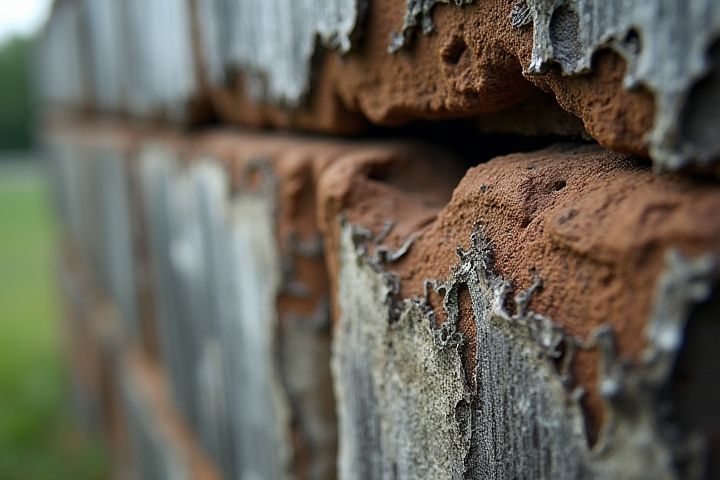
House damage refers to various forms of harm that can affect a home's structure, systems, and aesthetics, necessitating repair or renovation. This includes structural damage like cracked foundations, leaky roofs, and broken windows, which compromise the integrity of the building. Water damage, often a result of leaks, floods, or mold, can lead to severe problems such as rotting wood and compromised insulation. Pest infestations from termites or rodents also constitute house damage, threatening both safety and property value. Understanding these different categories of damage can help you maintain your home effectively and prioritize necessary repairs.
What Is Considered House Damage
Structural issues
House damage from structural issues typically includes compromised foundations, such as cracks wider than 1/4 inch or uneven settling. Significant roof damage, including sagging or missing shingles, can lead to water intrusion and further deterioration. Walls exhibiting large cracks or bulges signal underlying problems, often due to shifting soil or poor construction practices. Your home's overall stability is critical; thus, addressing these issues promptly can prevent costly repairs and ensure safety.
Water damage
Water damage refers to the destruction caused by excess water exposure, which can lead to issues such as mold growth, structural weakening, and electrical hazards. Common sources include leaking roofs, burst pipes, and flooding, which can compromise walls, flooring, and insulation. Signs of water damage often include discoloration, peeling paint, and musty odors, indicating potential underlying problems. It's crucial for homeowners to address water damage promptly to prevent costly repairs and health risks associated with mold and mildew proliferation.
Fire damage
Fire damage refers to harm caused by flames, heat, smoke, or even water used to extinguish a fire. Common indicators of fire damage include charred structural components, singed walls, and melted wiring or fixtures. Smoke damage can permeate materials, leaving behind strong odors and requiring deep cleaning or replacement of affected items. Understanding fire damage is crucial for homeowners, as it can significantly impact property value and safety, necessitating timely repairs and professional assessment.
Mold infestation
Mold infestation in your home can severely compromise indoor air quality and structural integrity. It often thrives in damp, dark environments, particularly in areas like basements, bathrooms, and under sinks. Signs of mold include visible growth, musty odors, and water stains on walls and ceilings. Timely remediation is crucial, as mold can lead to health issues, including respiratory problems, and can require extensive repairs if left unchecked.
Termite infestation
Termite infestation can result in significant house damage, affecting structural components such as beams, floors, and walls. The National Pest Management Association reports that termites cause approximately $5 billion in property damage annually in the United States alone, often leading to severe financial burdens for homeowners. Signs of termite activity include mud tubes, hollow-sounding wood, and discarded wings, which indicate an established colony within your property. Regular inspections and preventative measures are crucial to protecting your home from this destructive insect, as early detection can save you thousands in repair costs.
Roof damage
Roof damage includes various issues such as missing shingles, leaks, and structural destabilization, often resulting from extreme weather events like heavy rain, snow, or high winds. For instance, a single missing shingle can allow water to penetrate, leading to internal damage and costly repairs, with average repair costs ranging from $300 to $1,500 depending on the extent of the damage. If you notice sagging, water stains, or mold growth in your attic or ceilings, it may indicate significant roof damage requiring immediate attention. Regular inspections, ideally twice a year, can help you identify potential problems early, prolonging your roof's lifespan, which typically ranges from 20 to 30 years for asphalt shingles.
Broken windows
Broken windows are a common type of house damage, often resulting from extreme weather, accidents, or vandalism. They can lead to increased energy costs, with studies showing that windows account for up to 30% of heat loss in homes, significantly impacting your heating and cooling expenses. Repairing or replacing a broken window typically costs between $300 to $700, depending on the size and type of glass. Moreover, neglecting broken windows can compromise your home's security and may invite further damage from water intrusion or pests.
Plumbing issues
House damage from plumbing issues can lead to significant financial repercussions, with homeowners facing repair costs averaging between $1,000 to $5,000. Common problems include burst pipes, which can release gallons of water rapidly, causing severe water damage and mold growth. Leaky faucets and toilets not only waste approximately 10,000 gallons of water annually but also increase your water bill by up to 20%. Timely detection and maintenance of plumbing systems are crucial for preventing structural damage and safeguarding your investment.
Electrical problems
Electrical problems in a home can encompass a variety of issues, including faulty wiring, overloaded circuits, and malfunctioning outlets. Signs of electrical damage may manifest as flickering lights, burnt outlets, or frequently tripped circuit breakers, indicating a potential hazard that requires immediate attention. Additionally, water intrusion can lead to significant electrical damage, increasing the risk of short circuits or electrical fires. Ensuring regular inspections by a licensed electrician can help maintain your home's electrical system and prevent costly repairs from evolving into more serious safety concerns.
Foundation cracks
Foundation cracks are a significant indicator of house damage, often reflecting underlying structural issues. Vertical cracks typically suggest minor settling, while horizontal cracks may indicate more serious problems, such as soil pressure or water intrusion. Homeowners should be alert if cracks exceed 1/8 inch in width or if they appear alongside other symptoms like uneven floors or doors that stick. Addressing foundation cracks promptly can prevent costly repairs, with potential fix costs ranging from $500 to $4,000 depending on severity and treatment methods.
